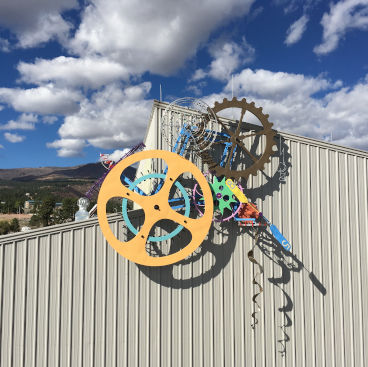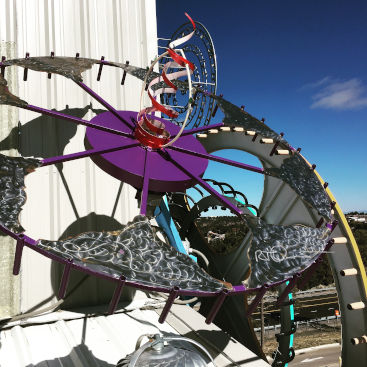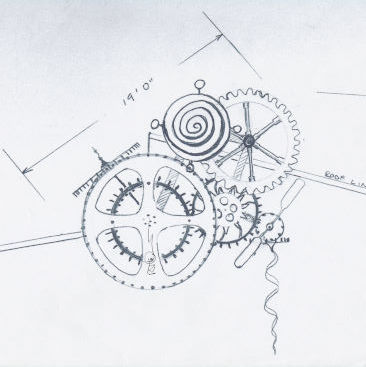Kinetic Metal Sculpture, Los Alamos NM
“The Industrial Machine” artwork by RTDavis was commissioned in 2011 by Los Alamos County under the Los Alamos Art in Public Places program.

The Vision

The Process
The Industrial Machine is made mostly of mild steel, but does have stainless steel parts and includes two wheels that are made of recycled aluminum. (It’s the recycling center, right?) The weird paddle/propeller thing is also recycled aluminum. The aluminum came from the Santa Fe Opera’s scene shop scrap bin—left over bits from opera set building. The spiral gear is also aluminum, but not made from scrap. It includes over a hundred small colored glass mirrors that sparkle in the sun as they go around.
I began this project by building a solar and wood heated shop on my property in San Pedro. The parts of this sculpture are big—the biggest wheel is ten feet six inch wide— and, while not terribly heavy, they are awkward to handle. The shop is built with an I-beam running the long way in the room and ten feet off the floor. Along this tracks a chain fall which can lift a ton or so. My brother, Jim, spent many days helping me build, but there were many times I needed to flip over a big wheel by myself, and this hoist allowed me to do this safely.
Once the gear-wheels and the armature were built, I attached the armature to my twenty-foot gooseneck trailer and put the gear-wheels on the armature for testing and painting and adjusting. When this part of the process was complete, I dissembled the sculpture, stacked it on the trailer, and took it up to Los Alamos to be installed on the building.
The installation took two days. The first day was installing some very heavy duty attachment points to the structure of the building. The armature was attached to these points on the second day in the morning, and the wheels were placed and bolted in the afternoon. The solar panel was also placed on the roof, and the electronics that operate the sculpture were placed at ground level.

Industrial Machine Mechanics
The Industrial Machine is made up of seven large wheels that are actually gears that mesh with each other and turn each other. Unlike normal gears where all the gear teeth are closely machined to mesh together perfectly, the teeth on these gears are all different, but mesh anyway. The center of each gear is bolted to a trailer axel hub that is welded onto the armature that is attached to the building. The hubs turn with little friction, and they are made to withstand much greater forces than they receive as part of this sculpture.
The sculpture makes its own power, and is not dependent on or connected to the power grid. It has a small solar panel mounted on the roof of the building that charges a backup power battery that can run the sculpture on a cloudy day. On sunny days, the solar panel makes plenty of power to turn the gears. The sculpture has a small gear motor that turns a drum connected to the purple gear that sits over the roof behind the big yellow gear. The purple gear drives the big yellow gear, and the big yellow gear drives the pink gear, etc. The power system senses the solar panel voltage and shuts the motor off at night, and starts it up again each morning. The motor starts in the opposite direction at each startup just in case something—ice? a kite?—gets caught in the gears.
The paint on this thing is just good quality, exterior house paint. The contract stated that this piece was to last twenty years, and there is no paint that can do that in the New Mexico sun…So, we paint it every few years to keep it looking fresh. We get a big articulated platform lift and mix the colors and paint it. And, yes, it’s really fun to do.
Visit the The Industrial Machine Photo Gallery